Typical heating distribution schemes in a private house: a complete classification of device options
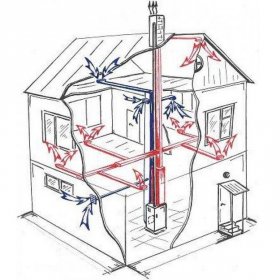
Living in your own home on the land offers several advantages, including the possibility of installing a heating system that is operated offline. Properly selected and installed wiring of heating in a private house allows you to organize fast, uniform heating of all rooms. The control of fuel consumption, calculated in accordance with weather conditions, provides a reduction in heating costs.
In practice, several proven heating schemes are used, differing in the type of coolant circulation (most often water), as well as in the method of distributing the main pipes. In most residential buildings, they install a one-pipe, two-pipe, radial or "Leningrad" heating system. Each heating house wiring diagram has its own characteristics, which are paid attention to when designing utilities.
Content
Water circulation methods in heating systems
The movement of fluid in a closed loop (s) can occur in a natural or forced mode. The water heated by the boiler rushes to the batteries. This part of the heating circuit is called forward stroke (current). Once in the batteries, the coolant cools down and goes back to the boiler for heating. This gap of a closed route is called a reverse stroke (current). To accelerate the circulation of the coolant along the circuit, special circulation pumps are used, cut into the pipeline at the "return". Models of heating boilers are available, the design of which provides for the presence of such a pump.
Natural coolant circulation
With natural circulation the movement of water in the system is "gravity". This is possible due to the physical effect that manifests itself when the density of water changes. Hot water has a lower density. The liquid going in the opposite direction has a high density, and therefore it easily displaces water already heated in the boiler. Hot coolant rushes up the riser, and then is distributed along horizontal lines drawn under a slight slope of no more than 3-5 degrees. The presence of a slope and allows fluid to move through the pipes by gravity.
The heating scheme based on the natural circulation of the coolant is the simplest, and therefore it is easy to put into practice. Moreover, in this case, the presence of other communications is not required.However, this option is suitable only for private houses of a small area, since the contour length is limited to 30 meters. The disadvantages include the need to install pipes of larger diameter, as well as low pressure in the system.

Scheme of an autonomous heating system at home with natural circulation of water (coolant). The pipeline is laid at a slope of no more than 5 degrees
Forced coolant circulation
In autonomous heating forced circulation systems (coolant) in a closed loop there is a mandatory circulation pump, which provides an accelerated current of heated water to the batteries, and cooled - to the heating device. The movement of water is possible due to the pressure difference arising between the forward and reverse flow of the coolant.
When installing this system, it is not necessary to observe the slope of the pipeline main. This is an advantage, but a significant disadvantage lies in the volatility of such a heating system. Therefore, in the event of a power outage in a private house there should be a generator (mini-power station), which will ensure the functioning of the heating system in an emergency.
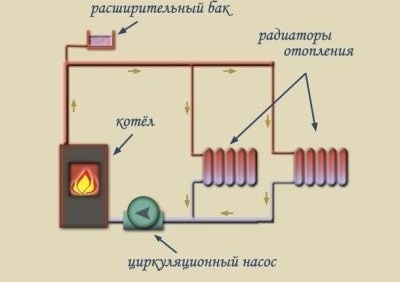
Scheme of organizing a home heating system in which the coolant is circulated by a circulation pump that cuts into the return current pipe
A scheme with forced circulation of water as a coolant can be used when installing heating in a house of any size. In this case, a pump of suitable power is selected and its uninterrupted power supply is provided.
Single pipe layout
In a heating system of this type, the heated coolant flows sequentially through all the radiators, while giving the appliances part of the thermal energy. They prefer to choose this scheme if a small budget is allocated for the device of the heating system. After all, for laying single pipe system you will need a minimum number of pipes, as well as related consumables.
One can not help but point out a number of disadvantages characteristic of a single-pipe heating system with an upper wiring, namely:
- the lack of the ability to separately control the level of heat transfer for each individual radiator;
- reduction in the amount of heat given off by the batteries to the room as they move away from the boiler.
«Leningradskaya»The heating circuit is designed to solve the problem of independently adjusting the heat transfer level of each individual battery. In a single pipe system, water flows through all installed radiators in series. The installation of shut-off valves on each battery and the installation of a bypass (bypass pipe) allows the coolant to circulate when cutting off a heating device.
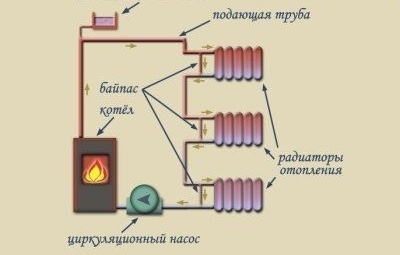
The single-pipe wiring of the Leningradka heating system makes it possible to switch off individual radiators using shut-off valves, while the coolant continues to move along the bypass pipe
Two-pipe system options
Main difference double pipe scheme heating of a private house is the connection of each battery to the main line of both direct and reverse current, which doubles the consumption of pipes. But the owner of the house has the opportunity to control the level of heat transfer of each individual heating device. As a result, you can provide a different temperature microclimate in the rooms.
When installing a vertical two-pipe heating system, the lower, as well as the upper, heating distribution diagram from the boiler is applicable. Now more about each of them.
Vertical Bottom System
Arrange it as follows:
- From the heating boiler, a supply main pipe is let on the floor of the lower floor of the house or in the basement.
- Further, risers are let up from the main pipe, which ensure that the coolant enters the batteries.
- A return current pipe departs from each battery, which leads the cooled coolant back to the boiler.
When designing the lower wiring of an autonomous heating system, the need for constant air removal from the pipeline is taken into account. This requirement is fulfilled by installing an air pipe, as well as installing an expansion tank, using Mayevsky taps on all radiators located on the top floor of the house.
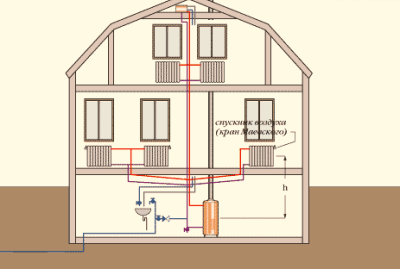
Scheme of a two-pipe autonomous water heating system for a house with a lower wiring. The coolant rises up the vertical risers from the central pipe
Upper Vertical System
In this scheme, the coolant from the boiler is supplied to the attic through the main pipeline or under the very ceiling of the upper floor. Then the water (coolant) descends down several risers, passes through all the batteries, and returns back to the heating boiler through the main pipeline.
For periodic removal of air bubbles in this system set expansion tank. This version of the heating device is much more effective than the previous method with a lower pipe layout, since higher pressure is created in the risers and radiators.
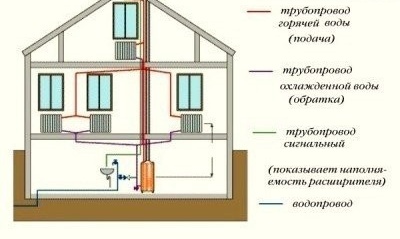
Scheme of a two-pipe autonomous heating system for a house with an upper wiring. The coolant moves up the central riser, and then goes down, passing through all installed radiators
Horizontal heating system - three main types
The device of a horizontal two-pipe autonomous heating system with forced circulation is the most common option for heating a private house. In this case, one of three schemes is used:
- Deadlock (A). The advantage is low pipe consumption. The disadvantage lies in the large length of the circulation circuit of the radiator farthest from the boiler. This makes it very difficult to adjust the system.
- Scheme with associated water promotion (B). Due to the equal length of all circulation circuits, it is easier to adjust the system. During implementation, a large number of pipes will be required, which increase the cost of work, as well as spoil the interior of the house.
- Circuit with a collector (beam) distribution (B). Since each radiator is connected separately to the central manifold, it is very easy to ensure uniformity of all rooms. In practice, the installation of heating according to this scheme is the most costly due to the high consumption of materials. The pipes are hidden in a concrete screed, which at times increases the attractiveness of the interior. The beam (collector) floor heating circuit is becoming increasingly popular among individual developers.
This is how it looks:

Three schemes of the horizontal two-pipe autonomous heating system, which are most often used in the construction of low-rise houses and private cottages
What is the best wiring diagram for heating circuits?
It is impossible to say clearly about the superiority of any one wiring scheme over others - it all depends on the number of floors, the availability of basements and the roof structure. One of the most common cases is a one-story house with a steep hip or gable roof. Regardless of whether there is a basement under the building, the best option is to arrange heating according to a two-pipe scheme with vertical risers. In this case, the wiring can be either lower or upper. The latter is preferable to use if the boiler is mounted on the ground floor, which is typical for buildings in which there is no basement.
Now we will consider the previous example of the house, however we will replace the steep roof with a flat one. The wiring is best done horizontally, placing the boiler in the basement.By the way, statistics show that for one-story buildings, a flat roof is used relatively rarely, while almost all of them are equipped with basements.
For two-story and multi-story buildings, both single-pipe and double-pipe heating circuits with vertical risers are allowed. In this case, you can use the upper or lower wiring. Only horizontal installation of the supply branches is not allowed. In general, almost any option, regardless of the type and design of the roof.
When choosing a typical wiring diagram, it is necessary to take into account many factors, ranging from the area of the house, and ending with the materials used in its construction. It is better to solve such issues with specialists in order to eliminate the likelihood of an error. After all, we are talking about heating the house, the main condition for comfortable living in private housing.
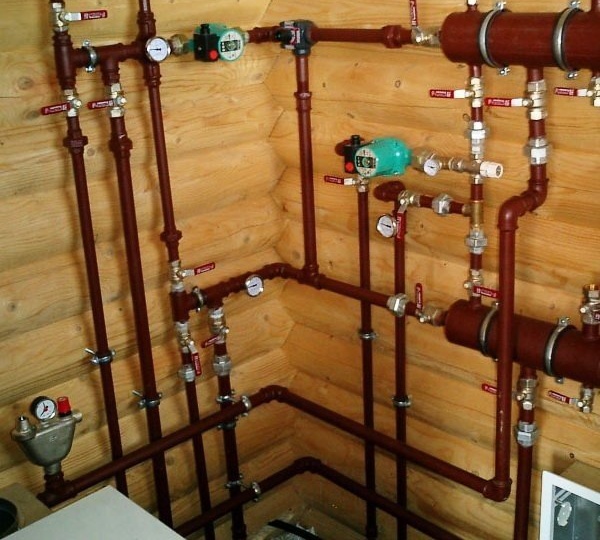
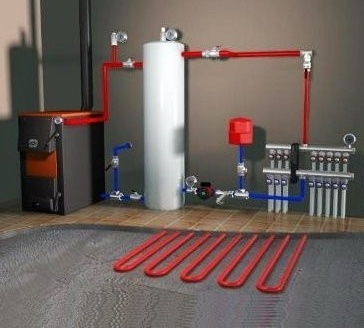
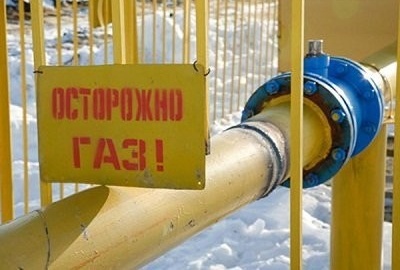
14 comments